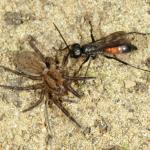Description and notes A medium-sized red and black spider wasp. Identification may be made from Day (1988). The male has a relatively distinct genital plate, but females are very similar to others in the subgenus Ammosphex Wilcke, and considerable care is necessary in identification.
Locally common in suitable habitat in southern England, extending northwards to Yorkshire and Lancashire, also occurring in Wales, mainly on the coast. It is also to be found in the Isles of Scilly and the Channel Islands.
Overseas it is known from northern and central Europe and across Asia to the Pacific coast (Wolf 1972).
This species is not regarded as being scarce or threatened.
Day, 1988 is the standard work for identifying British Pompilidae. Wiśniowski, B., 2009 is also useful.
A species of loose, sandy soils, it is most frequent in coastal sites but also occurs on southern heathland.
Single brooded, flying from May to August.
There are confirmed prey records of Xysticus (Thomisidae) and it may use spiders of the family Lycosidae too (Day 1988).
Little appears to be known, but like other related species it is likely to construct a nest in loose sand having already captured a spider and hidden it in nearby vegetation.
Wild parsnip (pers. obs.).
2006


